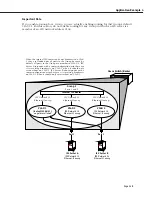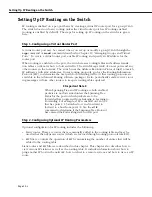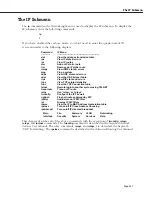
Application Example 2
Page 24-4
Application Example 2
VLAN
s in
IPX
Networks
Example 2 illustrates the use of AutoTracker
VLAN
s in
IPX
networks – specifically,
VLAN
s
based on
IPX
network address rules.
IPX
networks have unique characteristics that must be
considered when configuring
VLAN
s based on network address rules.
Encapsulation Type in
IPX
Networks
The encapsulation type a
MAC
station uses is very important in
IPX
networks, because a close
relationship exists between encapsulation type and
IPX
network number. In
IPX
networks, a
network number and an encapsulation type are configured for each segment. When two
IPX
servers share the same
LAN
segment, they must have the same network number and the same
encapsulation type in order to communicate. In addition, only clients and servers that use the
same encapsulation type can communicate. (The Omni Switch/Router removes this restriction
somewhat through
MAC
-layer translations, which will not be discussed at this time.)
In summary, network number and encapsulation type define a broadcast domain in an
IPX
network that is analogous to a
LAN
– or a
VLAN
. (Remember that
VLAN
s have the same charac-
teristics as
LAN
s, with the exception that
VLAN
s can span multiple segments as
LAN
s cannot.)
An encapsulation type is configured within each
IPX
client
prior to bootup on the
network. An
IPX
client acquires its network number dynamically from an
IPX
server (or from an interven-
ing router) using a “Get_Nearest_Server” mechanism. Upon bootup, each client sends a query
seeking the nearest server that uses the same encapsulation type as the client. Only those
servers using the same encapsulation type respond to the query. (An intervening router can
also respond to the query: routers traditionally interconnect
LAN
segments and can use differ-
ent encapsulation types for different networks.) This means that
IPX
clients do not know their
network numbers at bootup, but rather acquire their network numbers after they have
communicated with
IPX
servers or with an intervening router.
VLAN
Assignment in
IPX
Networks
The close relationship between encapsulation type and network number in
IPX
networks is
the main reason AutoTracker’s
IPX
network address policy requires you to specify both a
network number and an encapsulation type. The Omni Switch/Router assigns devices to
IPX
network address
VLAN
s as follows:
•
IPX
servers
. Frames from an
IPX
server always contain information on the server’s network
number, so the Omni Switch/Router can always assign
IPX
servers to the correct
VLAN
based on the server’s network number.
•
IPX
clients
. As explained previously,
IPX
clients do not know their network number at
bootup and so cannot, initially, be assigned to
VLAN
s based on their network number. For
this reason the Omni Switch/Router initially assigns clients to
IPX
network address
VLAN
s
based on their encapsulation type. An example of this is shown on the facing page. Once
an
IPX
client communicates with a server or an intervening router, learns its network
number and begins transmitting frames with that number, it is removed from all previously-
assigned
IPX
network address
VLAN
s (but not from
VLAN
s of other policy types) and placed
into the correct
IPX
network address
VLAN
according to network number.
So How Do I Avoid Conflicts?
As an example,
IPX
defines four different types of Ethernet encapsulation: Ethernet-
II
, 802.2,
SNAP
, and
IPX
802.3 (also referred to as “raw”). So, what do you do to avoid conflicts when
you have more than four servers and they use different encapsulation types? The solution is
to put each server into a different
VLAN
, as shown in the example on the facing page.
continued …
Содержание Omni Switch/Router
Страница 1: ...Part No 060166 10 Rev C March 2005 Omni Switch Router User Manual Release 4 5 www alcatel com ...
Страница 4: ...page iv ...
Страница 110: ...WAN Modules Page 3 40 ...
Страница 156: ...UI Table Filtering Using Search and Filter Commands Page 4 46 ...
Страница 164: ...Using ZMODEM Page 5 8 ...
Страница 186: ...Displaying and Setting the Swap State Page 6 22 ...
Страница 202: ...Creating a New File System Page 7 16 ...
Страница 270: ...Displaying Secure Access Entries in the MPM Log Page 10 14 ...
Страница 430: ...OmniChannel Page 15 16 ...
Страница 496: ...Configuring Source Route to Transparent Bridging Page 17 48 ...
Страница 542: ...Dissimilar LAN Switching Capabilities Page 18 46 ...
Страница 646: ...Application Example DHCP Policies Page 20 30 ...
Страница 660: ...GMAP Page 21 14 ...
Страница 710: ...Viewing the Virtual Interface of Multicast VLANs Page 23 16 ...
Страница 722: ...Application Example 5 Page 24 12 ...
Страница 788: ...Viewing UDP Relay Statistics Page 26 24 ...
Страница 872: ...The WAN Port Software Menu Page 28 46 ...
Страница 960: ...Deleting a PPP Entity Page 30 22 ...
Страница 978: ...Displaying Link Status Page 31 18 ...
Страница 988: ...Displaying ISDN Configuration Entry Status Page 32 10 ...
Страница 1024: ...Backup Services Commands Page 34 14 ...
Страница 1062: ...Diagnostic Test Cable Schematics Page 36 24 ...
Страница 1072: ...Configuring a Switch with an MPX Page A 10 ...
Страница 1086: ...Page B 14 ...
Страница 1100: ...Page I 14 Index ...
















































